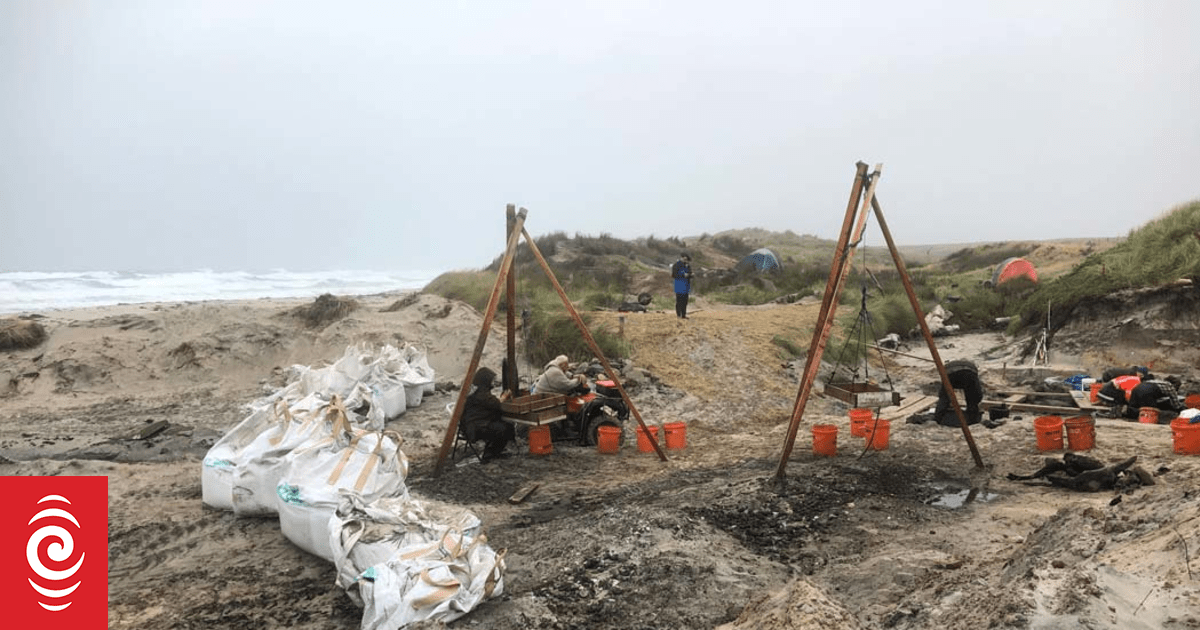By Shannon Pitman, Open Justice reporter of 
A judge found evidence overwhelmingly supported that the waka found in the Chatham Islands was of Polynesian origin.
Photo: Supplied/Manatū Taonga Ministry for Culture and Heritage
A woman has tried to halt investigations into an archaeological waka discovered in the Chatham Islands by claiming it came from Germany.
Her claim has been rejected by a judge, who found evidence overwhelmingly supported that the waka was of Polynesian origin.
The Māori Land Court’s recently released decision followed ongoing efforts to determine the rightful ownership of the centuries-old vessel.
It was discovered in August 2024 on the northern coast of Rēkohu Chatham Islands and was believed to be a Polynesian voyaging canoe, pre-European and of significant historical value.
Excavations concluded earlier this year, revealing more than 450 artefacts and several parties had since lodged ownership claims with the Ministry for Culture and Heritage.
The trustees of Hokotehi Moriori Trust and Moriori Imi Settlement Trust have jointly applied to determine ownership of the taonga, but another claimant, Catherine Sixtus, has emerged as a vocal participant.
Sixtus previously made headlines in 2022, when she unsuccessfully took legal action against then-Prime Minister Jacinda Ardern, pursuing her case through the High Court, Court of Appeal and Supreme Court.
Among her claims against Ardern was a declaration that Māori and Europeans were natural-born subjects of the Crown, alongside a series of other grievances.
More recently, Sixtus appeared before the Māori Affairs Committee, asserting that the South Island was an independent territory known as New Munster, complete with its own seal and a historical agreement with Germany.
In June, she formally joined the waka proceedings and, in September, sought an injunction from the Māori Land Court to halt any further removal, cleaning, sale, alteration or conservation of material from the site or its storage facilities – pending the appointment of an independent archaeologist.
Catherine Sixtus recently appeared before the Māori Affairs Committee.
Photo: YouTube
The decision didn’t provide any details about Sixtus’ interest in the waka and, when contacted by NZME, she declined to comment.
However, in her application to the court, she claimed the waka may have originated from the Hanseatic states of Germany.
“The most likely journey is that it was transported out of the port of Hamburg or one of the Hanseatic states of what is now called Germany,” Sixtus said in a memorandum to the court.
Sixtus said she believed the waka was carved by Sydney Parkinson, who sailed on Captain Cook’s first voyage on HMS Endeavour, and gave her theories on how it came to be buried.
“Preliminary analysis of reasonable probability that the vessel is made with New Zealand wood exported by High Chiefs to Germany, designed and manufactured by Native Moimoi Lutherans in Germany – namely ‘Te Nayti’ – transported to the Chatham shore by Native Moimoi and received by Moriori and buried,” Sixtus told the court.
Two other claimants, Jodie Boyce and Maxine Williams, also drew claims to the waka and referenced their German links.
“Ms Boyce says that her family are descendants of Charles Samuel Cave and Susannah Gage,” Judge Michael Doogan noted in the decision.
“She claims an interest in the waka, which she says may have been built by German Bell Beakers and that she is descended from Native, AB originals as defined in the Preamble to the Treaty of Waitangi and of the House Hohenzollen Protestant Line.”
In the decision, Judge Doogan found the assertions speculative and outside the scope of the court’s jurisdiction.
“With respect, I do not consider it is plausible on the basis of information currently before the Court that this waka originates from the Hanseatic states of Germany,” Judge Doogan ruled.
“The expert evidence so far available all points towards the Polynesian origin of this taonga.
“Even if I am wrong on the question of jurisdiction, I would not exercise discretion to grant injunctive relief.”
Sixtus’ application for injunction was dismissed.
A full archaeological report is due back in February 2026 and the taonga will remain the property of the Crown, pending further decisions on traditional or actual ownership from the court.
The Moriori Imi Settlement Trust was also contacted for comment.
* This story originally appeared in the New Zealand Herald.

